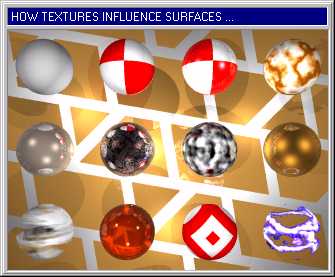

|
|
|---|
|
Using the POVLAB-texture library
· First of all: what we will not do is to explain all the details of texture-creating, -applying, -altering and so on. The interested reader is hereby referenced to the POVRAY-manual, which contains a valuable and - most of all - complete discourse of this matter. · What we will do, is to give a short overview concerning the main items of texture handling and how the first steps in applying and altering textures can be done in POVLAB. Nevertheless we will start with a ... Basic (and simplified) discussion on textures · What exactly is a texture? To bring it to the point: a texture describes the surface of an object. This description can contain information about »color« and »pigment«, »reflection« and »refraction«, »visibility« and »global surface-parameters« like »bumpyness«, »smoothness« and so on. 
|
· In the picture to the left, the changes are caused by the usage of different textures. Check out this image, to realize what textures can do.
· Let's have a look a the picture in detail (left to right): Background - this tiles surface shows a »pattern«. there a numerous patterns supported by POVRAY - all triggered by a special keyword and calculated by the raytracer. Patterns can highly be modified by the user. Sphere 1 - this shape has no texture at all! Its surface does not reflect or refract light, nor has it any bumps, nor does it contain any other surface-specific parameters. Spheres 2 & 3 - these objects were also modified with a pattern-keyword (»checker«), but the interesting thing is the difference in light-reflection. Wheras sphere 2 is pretty dull, sphere 3 seems to be polished, because there are »highlights« and »reflections« of the surrounding objects. Sphere 4 - this object was given the attributes of a special material (in this case it was »agate«). This makes the object look »stoney«. Sphere 5 to 8 - just like sphere 4, this tiles have special meterial-attributes, which makes them look like a specific metal. Note the difference in reflection (sphere 5 and 8), surface- turbulence (sphere 6) and bumpiness (sphere 7). Sphere 9 & 12 - this tiles not only have different pigments. Actually you can look through the objects (in certain regions). This habit is determined through »light-filters«, which can be altered by the user. Sphere 10 - this is glass! There are numerous kinds of glasses predefined in the POVLAB texture-library, all with their specific reflection-, refraction- and color- properties. · Though the image only shows a minimal assortment of availiable textures, one can imagine, that there are countless possibilities to combine, vary or distort textures to create or apply interesting surfaces or effects. |
| Chapter A/Page 23 |